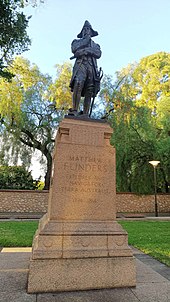Captain Matthew Flinders (16 March 1774 – 19 July 1814) was an English navigator who led the first inshore navigation of inland Australia.
Understand
editCaptain Matthew Flinders was an English navigator, cartographer and officer of the Royal Navy who led the second circumnavigation of New Holland, which he would subsequently call "Australia", and identified it as a continent. Flinders made three voyages to the Southern Ocean between 1791 and 1810. In the second voyage, George Bass and Flinders confirmed that Van Diemen's Land was an island. In the third voyage, Flinders circumnavigated the Australian mainland; heading back to England in 1803, Flinders' vessel needed urgent repairs at Isle de France. Although Britain and France were at war, Flinders thought the scientific nature of his work would ensure safe passage, but a suspicious governor kept him under arrest for more than six years. Although he reached home in 1810, he did not live to see the success of his widely praised book and atlas, A Voyage to Terra Australis. The location of his grave was lost by the mid-19th century, but archaeologists excavating a former burial ground near London's Euston railway station for the High Speed 2 (HS2) project, announced in January 2019 that his remains had been identified. Flinders' remains will be reinterred in the parish Church of St Mary and the Holy Rood in Donington, Lincolnshire, where he was baptised, on 13th July 2024. While largely forgotten in his home country England, he is a household name in Australia, where over 100 places and monuments have been named after him.
See
edit
- 1 Matthew Flinders Memorial, North Terrace, Adelaide, South Australia. Flinders is seen as being particularly important in South Australia, where he is considered the main explorer of the state. His statue stands on an attractive, tree-lined boulevard in a South Australian colonial tradition.
- 2 Flinders Island, a Bass Strait Island off the coast of Tasmania. James Cook named the islands Furneaux's Islands, after Tobias Furneaux, commander of HMS Adventure, the support vessel on Cook's second voyage. Flinders charted it, and it is unclear how they were renamed.
- 3 Ikara-Flinders Ranges National Park (The Flinders Ranges), South Australia (400 km north of Adelaide). An Outback mountain range in South Australia, reputed as one of Australia's great national landscapes, a rich environment to experience. The Flinders Ranges provide an emotionally uplifting and tranquil travel destination.
- 4 Bass and Flinders Memorial, Cronulla, New South Wales (south along the beachfront esplanade from South Cronulla Beach). Bass and Flinders discovered the Port Hacking waterway around Cronulla. A memorial to them and explanation of their journey is on the headland near the entrance to Port Hacking. Nice views across the river and ocean from here.
- 5 Matthew Flinders' Lookout, Urangan, Queensland. Commemorates Flinders' explorations of the Hervey Bay area.
- 6 Flinders Street Station, Melbourne CBD, Victoria. A famous landmark in Melbourne and favourite meeting spot for locals. The main hub of Melbourne's suburban railway network.
- 7 Flinders Chase National Park. National park in Kangaroo Island known for the bizarre rocks of the Remarkable Rocks, the colonies of fur seals at Admirals Arch, and the lighthouse at Cape Borda from 1858.
- 8 Towradgi, Wollongong, New South Wales. With the help of their friend Martin, Bass and Flinders made their attempted landing on the Illawarra coast. Nowadays a sea-side suburb of Wollongong for its convenient beach lifestyle.

